
Guests
- William Bastoneeditor of “The Smoking Gun” and lead author of the new article, “'Witness 40': Exposing a Fraud in Ferguson.”
As protests continue across the country over the police killing of Michael Brown, new questions are being raised about the grand jury that failed to indict Ferguson police officer Darren Wilson for shooting Brown. Many questions center on a woman identified in the grand jury documents simply as “Witness 40.” She told the grand jury that Brown charged at Wilson “like a football player.” Earlier this week, the website TheSmokingGun.com identified Witness 40 as Sandra McElroy. The website described her as a “bipolar Missouri woman with a criminal past who has a history of making racist remarks and once insinuated herself into another high-profile St. Louis criminal case with claims that police eventually dismissed as a 'complete fabrication.'” It now appears McElroy may have lied about witnessing the shooting, which occurred 30 miles from her home. On Tuesday, Rev. Al Sharpton said the report about Witness 40 gave new hope to the Brown family. He told the New York Daily News it shows the grand jury was “not a fair process.” We speak about the case with TheSmokingGun.com editor William Bastone. He is the lead author of the article exposing the identity of Witness 40.
Transcript
JUAN GONZÁLEZ: As protests continue across the country over the police killing of Michael Brown, new questions are being raised about the grand jury that failed to indict Ferguson police officer Darren Wilson for shooting Brown. Many questions center on a woman identified in the grand jury documents simply as “Witness 40.” She told the grand jury that Brown charged at Wilson, quote, “like a football player.” Her testimony largely supported Wilson’s versions of events and has been cited repeatedly on Fox News.
SEAN HANNITY: And then, quote, “He looked like a football player with his head down charging at Officer Wilson,” charged at him, quote—and I’m reading—”like a football player with his head down charging.” … That Michael Brown, you know, was charging like a football player, full force, on Officer Wilson. … One witness described it as charging at Officer Wilson like a football player with his head down. … Don’t charge him, to quote one of the eyewitnesses, like a football player with your head down.
JUAN GONZÁLEZ: Earlier this week, “The Smoking Gun” website identified Witness 40 as Sandra McElroy. The website described her as a, quote, “bipolar Missouri woman with a criminal past who has a history of making racist remarks and once insinuated herself into another high-profile St. Louis criminal case with claims that police eventually dismissed as a 'complete fabrication.'”
AMY GOODMAN: It now appears that Sandra McElroy may have lied about witnessing the shooting, which occurred 30 miles from her home. She gave conflicting accounts to prosecutors about why she was near the Canfield Green Apartments in Ferguson at the shooting. She first said she wanted to “pop in” on a friend she hadn’t seen in 26 years. Later she read from a notebook in which she claimed to have been visiting the neighborhood to conduct personal research to help her understand black people.
It has also come to light that she had a history of posting racist comments online and helped raise money for Wilson and other Ferguson police officers. On Tuesday, the Reverend Al Sharpton said the report about Witness 40 gave new hope to the Brown family. He told the New York Daily News it shows the grand jury was, quote, “not a fair process.”
Joining us now is William Bastone, editor of “The Smoking Gun.” He co-authored the piece exposing the identity of Witness 40.
Tell us more about her. And how did you find out who she was?
WILLIAM BASTONE: Well, what we did is we looked at two volumes of her grand jury testimony, which is heavily redacted, but we zeroed in on the portions that gave a little bit of biographical detail about her—excuse me. And we used that information—you know, everything from the fact that she was adopted, divorced, had a couple of felony convictions and some other stuff—and then we basically went online and looked at some—a Facebook page that we believed she was associated with. And I’ll spare you all the details, but by a process of elimination, we zeroed in on her, figured out—got her name, and then we went and checked on Sandra McElroy’s background, and it basically dovetailed exactly with Witness 40—everything.
JUAN GONZÁLEZ: Now, in her testimony, she had admitted that she had been convicted of—
WILLIAM BASTONE: Check fraud.
JUAN GONZÁLEZ: —check fraud, right?
WILLIAM BASTONE: Two felony counts of check fraud in 2007, had received three years of probation, a suspended sentence. And so, you know, then we reached out to a couple other people who had had interactions with her, and it made us convinced it was the same woman.
AMY GOODMAN: So, how was she presented to the grand jury? What did the police know? What did the district attorney know? And explain exactly what she said.
WILLIAM BASTONE: Well, she initially—she was not found by law enforcement. She approached law enforcement more than a month after the incident. She approached the St. Louis County police, gave an account of what occurred. Five weeks later, she met with the FBI and two Justice Department prosecutors, and then a day after that, they put her in the grand jury for the first time. So, she comes up with this story, that she sat on for a month, and tells the cops this story, and then five weeks pass before she basically goes into the grand jury.
And the thing that is incredibly puzzling is that I don’t think that anyone attempted to determine whether what she told them was true or not, because as we point out—I don’t know if we point out in the story, but our interest in investigating her began and our—found out who she was and everything about her, it took us two days to do that. We don’t have subpoena power. We can’t get her phone records. It took us, two reporters, three days to find her. And the cops had five weeks to find out. First, the story, on its face, was wholly unbelievable. And there were just simple investigative tasks that the cops could have done that could have disproven her. So, what they did, who knows what they did? But what the effect is, is, as I think we point out in our story, is that they basically allowed her story now to get baked into the narrative of the grand jury.
JUAN GONZÁLEZ: Well, interestingly, her claim—her initial claim, because she changed the story, right? Her initial claim was, because she was a white woman in a largely black neighborhood, that when she was asked why she was there, was that she was trying to find a former high school friend that she hadn’t seen in over 20 years, and got lost, couldn’t find the address and got out of her car to ask for instructions. So—
WILLIAM BASTONE: And then, amazingly, this cataclysmic event happens right in front of her. What luck!
JUAN GONZÁLEZ: So, you would think the police would at least say, “Well, let’s see in the surveillance footage if—or the video footage, if her car is anywhere in the vicinity.”
WILLIAM BASTONE: Right. Well, they actually eventually did that. When she was—when she was questioned by the FBI and the two Justice Department prosecutors, they basically said to her, “You know that there are surveillance cameras in the area, and no one picked your car up. How could that be?” And she had no explanation. And they asked her, “Well, how did you get there?” And she described her path of getting there. And then they said, “Well, after it occurred, how did you leave?” And she gave an explanation that was impossible based on the way the roads were. There was—it was very clear that she looked at a map of the area, and she—looking at a map, or if you go online, MapQuest or Google Maps, it appears as if there is a pathway out of the area, and that’s the way she took. But that thing has been closed for like two or three years, and if you had physically been there, you would have known there was only one way out.
So, the story fell apart. And they kind of picked the story apart. But, you know, what you don’t really know is there are 12 grand jurors in there, and you don’t really know if anyone bought part of her story or that figured into their final decision, which is really kind of the scary part of it. It’s like—it’s like a person comes up with an insane story, approaches the cops with it, and usually the way it works is, like, “OK, thank you for coming in. We’ll be in contact with you,” and then they’re never heard from again.
AMY GOODMAN: So, your article notes that Sandra McElroy appeared at the Ferguson grand jury November 3rd with a spiral notebook purportedly containing her handwritten journal entries from August. The opening entry in her journal on the day Brown died declared, quote, “Well Im gonna take my random drive to Florisant. Need to understand the Black race better so I stop calling Blacks Niggers and Start calling them People.” That was her quote. I never use that word, except this is so significant right now because she used that word. What did Bob McCulloch understand about who she was?
WILLIAM BASTONE: Well, yes, it was at the end—it was in the waning moments of her first appearance in the grand jury, on October 23rd. I mean, she was virtually out the door, when she says, as a matter of fact, “Oh, you know, I wrote all this stuff down in my journal after it happened.” And they were—”Would you like to see it?” And they were like, “Sure,” you know, and that meant she was coming back.
So, 10 days passes, and she appears with this one volume that is her—it’s a notebook, her August notebook, and everything that precedes August 9th are like one-line entries. You know, I wrote in the piece, you know, they probably should have checked to see if the ink was wet on the notebook, because there’s no doubt what she did is—it was created after the fact to buttress this harebrained story that she told.
And, you know, it just seems like if—you know, we point out in the story, like, we went back and looked—you know, we knew what her Facebook handles were, and we knew what her YouTube account was and her Twitter account was. And she—you know, after the shooting, even after her grand jury testimony, she was saying these incendiary things online. And it just—
JUAN GONZÁLEZ: Well, that’s the other—could you talk about that, what you found out from her social media accounts in terms of her biases and also her support of Darren Wilson and police officers, in general?
AMY GOODMAN: And if you talked to her?
WILLIAM BASTONE: Yeah, I’ll tell—yeah, I’ll explain that, as well. Yeah, we looked. You know, she is a very active commenter on Mike Brown. And she has a couple of Facebook accounts that we’ve linked to her, and she’s acknowledged after the fact they’re hers. And she was constantly commenting about the case, supportive of Officer Wilson. And she would do things like she would—most of what she would do is she would be in the comment sections on television stations or print publications. You know, there’s a story, and then there’s the comments underneath, and she’d hop in there. And she’d do things like, one afternoon, commenting on some news story about Ferguson, she just posts a graphic, that floats around in these kind of right-wing circles, and it’s a photograph of Michael Brown lying dead in the street, and it’s captioned something along the lines of “Stop asking for justice for Michael Brown. He got his justice,” you know, and it’s a photo of him dead in the street. And she constantly was doing stuff like that, and “Pray for Officer Wilson.”
And, you know, when she was in the grand jury, she basically denied that she was like a stooge for Officer Wilson—she was just there to tell the truth. You know, and she was involved in a Facebook page that she started 10 days after the shooting that purportedly was there to support law enforcement officers and first responders in Ferguson, and had nothing to do with Officer Wilson. They were raising money in a kind of a crowd-sourced fashion. And in the end, they donated all the money to the Officer Wilson trust fund. So, you know, I mean, this was all easily obtainable.
AMY GOODMAN: Could she be charged with perjury?
WILLIAM BASTONE: Well, she should be charged with perjury. She lied to the cops. That’s making false statements. The first time, September 11th, when they—when she sat down and she spoke with the FBI and the Department of Justice, she lied to them. The first time they put her in the state grand jury, she lied. The second time, she admitted she lied the first time and then lied again. So, she’s got—yeah, she should.
You know, and it’s one of these things where, yes, she has said that she suffers—she’s been diagnosed as being bipolar and that she has bouts of mania. But, you know, you—she insinuated herself into a case of national importance and spun out a story that was totally untrue. And do you walk away from that without some sort of—you know, the government just saying, “Oh, that’s fine. Next time something like this happens, if you’re a lunatic and you want to come forward and create a story that’s going to back up the cops, come on in. We’re happy to have you”?
JUAN GONZÁLEZ: But the bigger—that’s the bigger question, in my mind. It’s not what she did, but what prosecutors did, because either—
WILLIAM BASTONE: It’s mystifying.
JUAN GONZÁLEZ: —they were totally inept in one of—as you say, one of the biggest cases in recent times, of national attention, or they knew or suspected that she was lying and didn’t care, which was even worse.
WILLIAM BASTONE: Well, you know what? If you’re a prosecutor and you know that someone’s going to come in into a grand jury and lie, you can’t really allow them to do that. That’s called creating a perjury trap.
AMY GOODMAN: Can a new grand jury be convened, based on this?
WILLIAM BASTONE: I don’t know. I mean, I think that’s probably a fairly tough thing to do.
AMY GOODMAN: And you spoke to her?
WILLIAM BASTONE: Yes. I mean, she would not talk to us before the story came out. We published the story on Monday morning. Yesterday, I corresponded with her, in which she admitted that, yes, in fact, she was Witness 40, and she expressed concerns for the safety of her three minor children, and she’s trying to erase her social media presence. And then I had a—she wanted to have a conversation off the record, which we had a lengthy conversation off the record. And hopefully we’ll maybe try to see if she’ll want to move some of that on the record.
JUAN GONZÁLEZ: Well, and, of course, Witness 40 was—the importance of her testimony was that she, and there’s at least another witness, as I recall, Witness 10, who were the ones who said that Brown charged at police officer Wilson. And so, obviously, if her testimony is impugned, then the issue becomes: What about this other witness? And I want to turn to MSNBC’s Lawrence O’Donnell. Late last month, he dissected the credibility of that other witness, Witness 10.
LAWRENCE O’DONNELL: Witness number 10 was working in the neighborhood, and he begins his story to the police with: “I seen the two young guys walkin’ down the street on the same sidewalk that I was on.” Six weeks later, witness number 10 testified to the grand jury and changed his story about where Michael Brown was walking. He said under oath to the grand jury, “I seen Mike Brown and his friend walking down the street closer to the curb, not on the sidewalk.” That is the kind of thing the district attorney was complaining about last night—witnesses changing their stories to fit the publicly known facts.
Here is why witness number 10 was the most important witness to appear in Darren Wilson’s defense. This is what he described Michael Brown doing when Officer Wilson got out of the car and chased him: “[Michael Brown] stopped. He did turn. He did some sort of body gesture. I’m not sure what it was, but I know it was a body gesture. And I could say for sure he never put his hands up after he did his body gesture. He ran towards the officer full charge.” So there’s witness number 10 saying the magic words: He never put his hands up, and he ran towards the officer full charge.
In the grand jury, when the prosecutor asked witness number 10 to describe what he called a “body gesture,” he said, “I can’t say for sure what sort of body gesture. I cannot fully recall. All I know is it was not in a surrendering motion of I’m surrendering, putting my hands up or anything. I’m not sure if it was like a shoulder shrug or him pulling his pants up. I’m not sure.” So, there’s the district attorney’s favorite witness, the only one he quoted last night, saying, “I cannot fully recall. … I’m not sure. … I’m not sure,” within the body of an answer in which the only thing he’s absolutely sure of is that Michael Brown did not do a surrendering motion. In a real courtroom, when a witness begins his answer with “I can’t say for sure,” and then in the body of his answer he says, “I cannot recall fully,” and then says, “I am not sure,” twice within that same answer, that witness observation does not survive cross-examination. But there was no cross-examination in the grand jury room.
AMY GOODMAN: That was Lawrence O’Donnell on his show on MSNBC, Last Word with Lawrence O’Donnell. And he went on from there. His final point about [witness] number 10 is that when he was asked by the police how far away he was, he said about a hundred yards—a football field away. When he goes into the grand jury, he says something like 50 yards—he cuts it in half—or 50 to 75 yards. Can he see? Does he wear glasses? None of those questions, because this isn’t a trial. This is a grand jury. Juan?
JUAN GONZÁLEZ: Yeah, well, in light of this, Bill, your sense of—because obviously there’s still a federal investigation going on, and this kind of a dissecting of these witnesses and the testimony, that led the grand jury to decide there was no reason to indict, will certainly catch the attention, hopefully, of the federal investigators.
WILLIAM BASTONE: Yeah, I would think that—I have hopes that the investigation that they would do would be a lot more thorough than the local law enforcement agencies have proven to be capable of undertaking. I would assume that there—if someone says they were there, there’s going to be a good attempt of trying to figure out, in fact, whether they were there. Did they have their cellphone? Did it ping off of a cellphone tower? You know, anything. Is their car on any of the surveillance video outside some of these buildings? I mean, the Witness 40, McElroy, you know, conveniently, when she took this 30-mile drive up there, she left her cellphone at home. You know, I mean, there’s so simple ways to just go get her—go get her cellphone bills. You know, there’s like a six- or seven-hour time. If she placed one—she doesn’t have a landline. If she placed one phone call off of her cellphone, you’d pick it up off of—it’d ping off of a tower, and you’ll know she was nowhere near Ferguson at the time. You know, and the other thing is that when she testified the first time in the grand jury, it was one day after the St. Louis Post-Dispatch published a lengthy story that detailed exactly what Darren Wilson told police about his version of events. And if you look at that story and you look at her testimony, you wouldn’t be able to tell the two apart. So you get a good idea where she came up with all the facts.
AMY GOODMAN: Well, William Bastone, we thank you so much for your reporting. Of course, we’ll continue to follow this. And what does this mean for a grand jury? Could there be another grand jury? What does this mean for the prosecutor, for Bob McCulloch? William Bastone is editor of “The Smoking Gun” and lead author of the new article, “'Witness 40': Exposing a Fraud in Ferguson.” We’ll link to it at democracynow.org.
When we come back, what’s happened to James Risen, the Pulitzer Prize-winning journalist for The New York Times? What is the Justice Department now offering him? Does he still face years in prison for refusing to reveal a source? Stay with us.

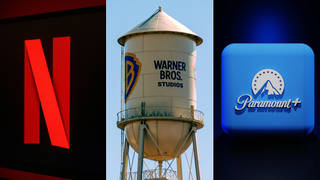
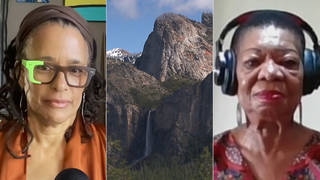
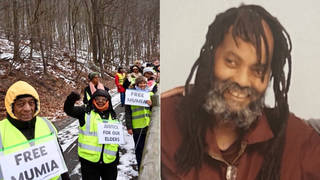
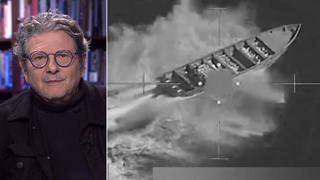





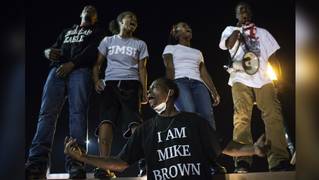

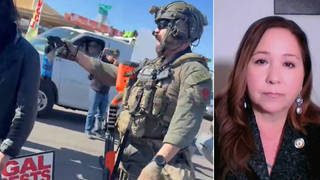
Media Options